This was published 3 months ago
How Australia’s ‘flood capital’ is rebuilding, two years on
Slowly, and ever so tortuously, downtown Lismore’s shabby chic glory is returning. With hundreds of millions of dollars being poured into the region, community leaders want locals - not insurers - to shape the city’s future.
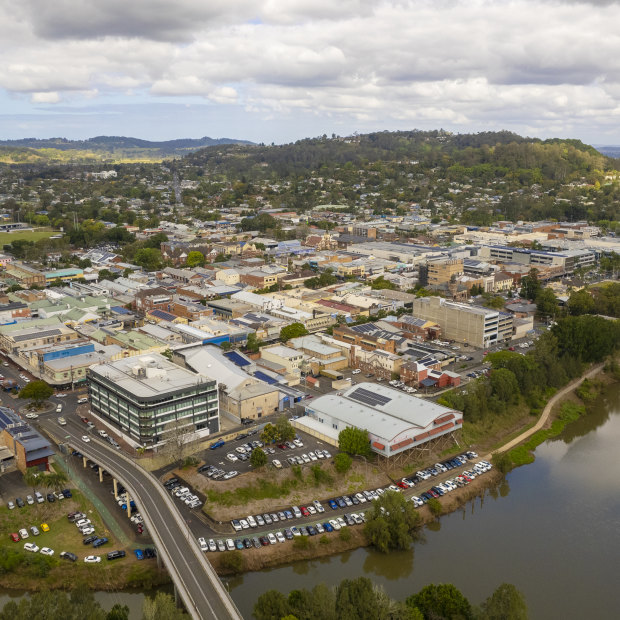
Lismore city centre, September 2024.Credit: Danielle Smith
Lismore is an implausible character after the 2022 floods, a bipolar vortex of contradictions, a mess of extreme highs and crushing lows, attractions and repulsions that no one could have imagined.
Hundreds of millions of dollars are being poured into a reconstruction-driven facelift of the grand dame of the Northern Rivers of NSW and the surrounding towns.
Slowly, and ever so tortuously, downtown Lismore’s shabby chic glory is returning. John Stewart wants to tap into that reconstruction energy.
In August, two and a half years after one of Australia’s biggest natural disasters, Stewart lodged a development application to convert a cavernous 124-year-old department store site into a school ready for 400 fee-paying pupils from years 5 to 8.
He plans to invest $6 million, including a $1.3 million federal grant, in a two-stage regeneration of the old Brown and Jolly site in the heart of Australia’s flood capital.
Twenty-nine big floods – 9.9 metres or higher – have swamped this downtown Lismore area since 1870. After a 10.65-metre high levee was built in 2005, only three floods have entered the CBD. The 2022 disaster – a record 14.37 metres – was two metres above the previous biggest recorded events in 1954 and 1974.
“We are committing to the people who are committed to Lismore … a really cool, creative regional centre, which happens to go through floods, and we’re saying we can manage floods and live through those floods too,” the Living School founder says.
“I don’t want insurers defining what happens in our community. The community should have their choice about what happens in this city.
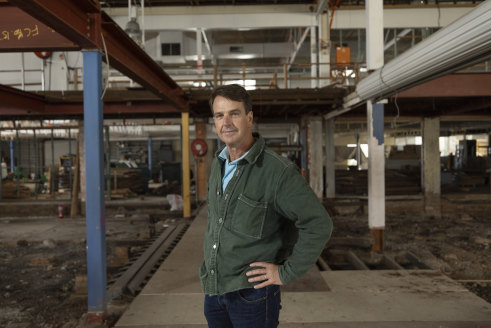
Living School founder John Stewart has lodged a multimillion-dollar DA to convert an old Lismore department store into a campus for 400 students.Credit: Danielle Smith
“But I think everybody has to take responsibility [financially] for that decision and act in a way that’s reasonable and responsible.”
Stewart is far from alone in taking a punt on this old girl. Commercial occupancy rates in the city centre are nudging towards 80 per cent. Before the flood they were hovering about 90 per cent. Six months after the flood, it was 38.3 per cent.
All hope to “breathe a bit more life into Lismore”.
What helps is the $7 billion pipeline of federal and state money – roughly the same size as the 2032 Brisbane Olympics budget – flowing into the Northern Rivers region over the next four years.
The NSW Construction Authority and local councils will coordinate pre- and post-flood infrastructure projects, which will include new bridges and roads, sewerage and water treatment plant upgrades, and new schools and ambulance stations on higher ground.
Seven flood-free sites also have been identified in East Lismore, North Lismore, Goonellabah, Brunswick Heads, Ballina-Lennox Head, Casino and the Clarence Valley to deliver 4300 new parcels of residential land.
Every month, a roll call of reimagined, repaired or rebuilt civic buildings and facilities is presented, like some kind of post-disaster country debutant ball, to the same smiling local representatives: Labor State MP Janelle Saffin, Federal Nationals MP Kevin Hogan and Mayor Steve Krieg.
Last month, they welcomed the Lismore Regional Sports Hub – Oakes Oval and Crozier Field – after a 12.4 million upgrade. This month, the Lismore Art Gallery is sliding open its doors once again, while three blocks downtown, the Lismore Workers Club is launching its $17.5 million rebuild.
Reconstruction gold rush
After the disaster’s initial mishandling by the little-mourned Resilience NSW and the overpromising of housing by the now-defunct Northern Rivers Reconstruction Corporation, there are also visible changes in the worst-hit residential areas.
Of more than 3500 houses left uninhabitable across the Northern Rivers, about 1100 properties are expected to receive a buyback. By September 6, the NSW Reconstruction Authority, which now oversees the scheme, had approved 814 buyback offers, 675 offers have been accepted and 517 buyback purchases have been completed. About 350 homes have been identified as eligible for home raising or retrofitting.
It’s a reconstruction gold rush. But what happens when the roll-out ends?
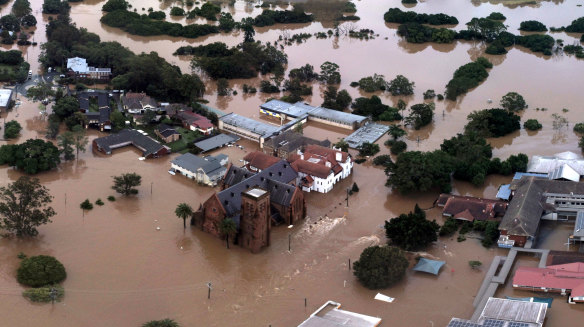
Lismore in February 2022.Credit: Getty
Neither the NSW government, Lismore City Council, nor the region’s local government bodies have reached any solid agreement on how to map out a future, paralysed between proselytisers for flood-proofing the city centre at any cost and advocates for abandonment in any case.
It appears that the masterplan for both how Lismore should evolve, and protecting the wider region from flooding – both mutually entwined – rests solely on the laboriously titled Northern Rivers Resilience Initiative.
Armed with $11.4 million in funding through the National Emergency Management Agency, research hydrologist Dr Jai Vaze and his CSIRO team are attempting to answer one question: will it be possible to reduce the risk faced by the residents and businesses of Lismore and its surrounding towns when the next flood disaster hits?
They have mapped the region’s entire river and creek system and are now building a detailed hydrodynamic model for the Richmond and Wilson river catchments. Once this model is ready, the CSIRO wants to determine the impact up to three different mitigation scenarios or interventions could have on flooding creek and river flows: holding them back, slowing them down or changing course through bypasses or channels.
It is widely viewed that the proposed interventions will neither be small nor inexpensive.
Vaze has warned that there are no simple solutions. A series of detention-retention basins to hold back or slow down the flow of floodwater in the upper catchment, for example, could potentially cost hundreds of millions of dollars and generate huge environmental controversy
The CSIRO’s answers – and cost estimates – to whether any of the mitigation options will address the problems are expected to be ready by 2026. Any workable solution, if it exists, will take years of wrangling to fund and even more to build. And, to make matters worse, the various stakeholders are still warring over what scenarios should even be tested.
Uncertain future
Elizabeth Mossop, who was extensively involved in the recovery and rebuilding of New Orleans after Hurricane Katrina and now lives in Lismore, says the big-picture planners have lost sight of the medium-term future.
Mossop heads Living Lab Northern Rivers, which is backed by the University of Technology Sydney, Southern Cross University, and the NSW Reconstruction Authority. It is looking to combine local knowledge and aspirations with technical expertise to co-design a sustainable future.
The idea for the lab emerged from inside SCU in the immediate aftermath of the flood when the university became the main evacuation centre for residents and a base for many government service providers and relief efforts.
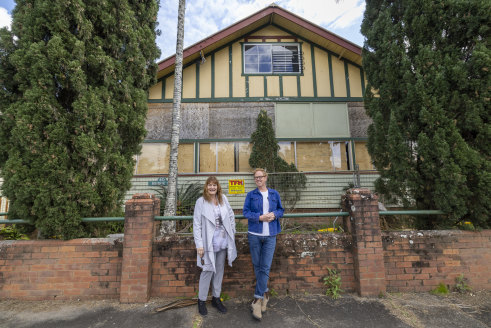
Boarded up: Elizabeth Mossop and Dan Etheridge walking through the streets of Lismore where floods have ruined houses.Credit: Danielle Smith
“Everyone is waiting to see what comes out of the CSIRO flood modelling,” Mossop says. “But people are making decisions now, ‘Do I sell my house? Do I take the buyback? Do I stay in Lismore? Do I try to get a job somewhere else?’
“And the problem is that the longer this uncertainty goes on, and it could be years, the less likely people are to invest in a future Lismore.”
In June, the Lab team presented ideas to the local community about how Lismore could look ahead in this interim period. These included a revitalised floodplain with cultural land management, recreational trails, gardens, and markets; commercial flood-resilient retrofits in the Lismore CBD; new urban villages created above the floodplain; and a naturalised creek forming the spine of a new greenway connecting the CBD and urban villages.
These ideas have also been presented at special briefings for NSW ministers and public service heads at Parliament House in Sydney.
However, long-time community advocate Richard Trevan, who with his mother Beth first called out systemic failings and degradation of the State Emergency Service after the 2017 flood, is concerned that the Living Lab advocacy, partially funded through the NSW Reconstruction Authority, will mask a sliding NSW government commitment to lower the impact of regular flooding and provide long-term protection against droughts as well.
“After two-and-a-half years, there is no plan,” he says. “The NSW government and council are tripping and stumbling along.
“We need a medium-term plan for the next five years, but we also need one for the next 15–50 years.
“I fear that everything else is mere tinkering. The reality is, it’s every man and woman for themselves, and I have real fears about what’s on the other side when the reconstruction money runs out. It doesn’t have to be this way.”
‘Be prepared’ and embrace floods
John Stewart, a former headmaster of Southern Highlands’ Tudor House, is one person who got tired of waiting for Lismore to take the great leap forward.
Instead, the Living School founder wanted to put into practice the Indigenous idea of embracing floods as part of life and, when they come, “be prepared to move and be prepared to come back once it’s a settled space”.
The 4800-square-metre department store building, bought for $1.45 million in 2020, will embody that philosophy, he says.
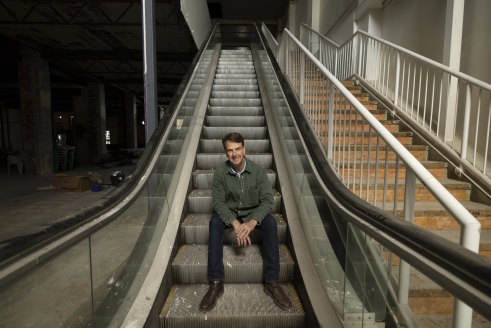
A water slide will replace this old escalator in John Stewart’s floodproof project.Credit: Danielle Smith
The building will adhere to the industrial warehouse aesthetic now popular across the Lismore CBD: all-concrete floors, exposed beams and pillars, and no gyprock walls. However, the lower floor will be opened up more radically to allow flood water to enter and leave more easily.
Sections of the roof will be removed for an indoor rainforest to be planted in a section lower than the ground floor, acting as a giant sump when flood contaminants and mud are hosed out.
‘I grew up in downtown Lismore … so I’m not cavalier or naive. I just think we can safely live within this environment and share this experience with our community.’
John Stewart, Living School founder
The school will also have its own buses and trucks to move any perishables or other essential items to flood-free sites at SCU or outside Lennox Head.
An existing second floor – above the 2022 flood height – will be extended. Giant lifts and trolleys will be installed to quickly and easily remove furniture and anything else from the ground floor to higher ground.
Sections of the roof and wall open up to allow greater airflow and sunshine in to help dry out the building after the floodwaters subside. The school will also have its own generators to power large heaters and fans to assist this process.
And, for a bit of fun, and nothing to do with flood resilience, the old store escalators will be replaced by slippery dips for the students.
“We’re not looking at building a new building,” Stewart says. ” It would have cost me $65 million on a flood-free site.
“What we’re looking at is how do we manage a flood. And the DNA of this building, its skeleton, has been able to withstand any floods over more than 100 years, even the biggest flood in history.
“I grew up in downtown Lismore, and I was in the ’74 flood, so I’m not cavalier or naive. I just think we can safely live within this environment and share this experience with our community.”
The Morning Edition newsletter is our guide to the day’s most important and interesting stories, analysis and insights. Sign up here.